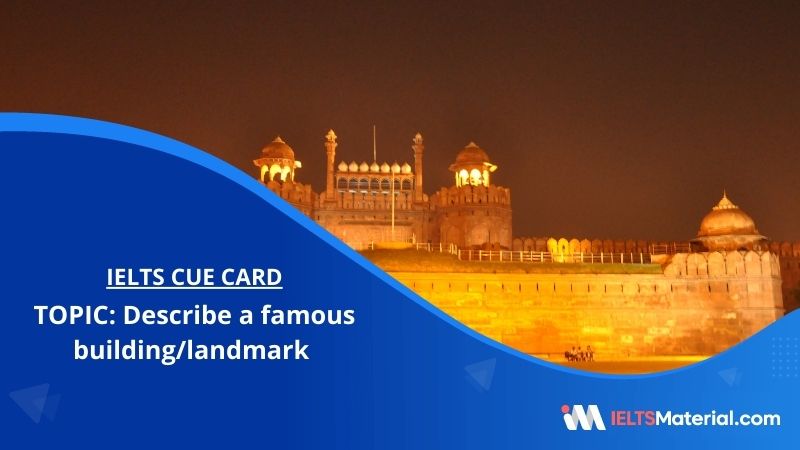Describe a famous building/landmark – IELTS Cue Card
Table of Contents

Limited-Time Offer : Access a FREE 10-Day IELTS Study Plan!
Describe a famous building/landmark
You should say:
- Where it is?
- How old it is?
- How does it look?
And explain why you think it is an important landmark/ building.
Sample Answer 1
I relish going to new areas and seeing the grandeur of the modern architecture. The Sydney Opera House, located in Australia’s largest city, Sydney, is one of my favorite sights. Australia also contains a variety of man-made structures and sites that demonstrate what man can do when determination and leverage are at the forefront of human civilization. The enormous, one-of-a-kind edifice serves as a reminder that humans can achieve anything.
The Sydney Opera House is a late-modern masterpiece by Jorn Utzon that pushed architecture and engineering to new heights and has had a lasting impact on late-twentieth-century and beyond architecture. The design is an outstanding interpretation and response to Sydney Harbour’s surroundings. It is known for the architecture of its roof, which resembles shells or sails. Moreover, one million roof tiles cover the roof. These were manufactured in Sweden. There are various performance rooms, theatres, and exhibition spaces in the opera house. Every week, around 40 concerts are performed here.
It is, in my opinion, one of our city’s most popular tourist attractions that not only generates a large amount of revenue but also introduces visiting tourists to our local culture. The Sydney Opera House is now one of the world’s busiest performing arts sites, hosting up to 2500 performances and events each year, attracting 1.5 million patrons and an estimated four million visitors. The design is an astonishing interpretation and response to Sydney Harbour’s surroundings. The Sydney Opera House’s structural engineering and construction technology achievements are remarkable universal worth. The structure is a significant artistic landmark and an emblem open to the public.
Sample Answer 2
India is a country of diversity with different cultures, languages, religions, and food. With every turn one takes in any city or village of this country, one will experience something new. Among the various well-known monuments that interest me, the Red Fort is one of the best examples of Mughal architecture, besides the Taj Mahal.
Also known as Lal Qila, the Red Fort is located in the old part of the country’s capital, Delhi. It has derived its name from the red sandstone which was used to build this incredibly complex structure. In 1638, the fifth Mughal emperor, Shah Jahan commissioned to establish a fort to protect his new capital, Shahjahanabad, presently known as Delhi. It had remained the seat of power of all the Mughal emperors after Shah Jahan.
[do_widget id=custom_html-22]
The construction of the Red Fort was completed around 1648. It is built over an area of 255 acres. In its history of more than 370 years, it has been part of many historic events. In 1739, the Persian ruler, Nadir Shah pillaged the city. He destroyed many beautiful parts of the Red Fort and took away the Peacock Throne which was housed in the Diwan-i-Khas till then. When the British took over, some of the marble structures of the Fort were destroyed during the 1847 revolt. After Independence, the first Prime Minister of India, Pt. Jawaharlal Nehru addressed the nation from the Red Fort making this structure one of the most powerful representations of sovereign India.
The Red Fort was originally designed in red and white because those were the favorite colors of Shah Jahan. It comprises halls like the Diwan-i-Khas and Diwan-i-Am, palaces like the Rang Mahal and the Mumtaz Mahal, and beautiful gardens like the Hayat-Baksh-Bagh and the private halls which are connected by the Nahr-i-Behisht, which means the Stream of Paradise. Apart from these, the Red Fort has two important gates – the Lahori Gate, which is the main entrance to the fort, and the Delhi Gate which is used for public entrance at the southern end of the complex.
[do_widget id=custom_html-47]
In 2007, UNESCO added the Red Fort to the list of World Heritage Sites in Delhi due to its remarkable history and sublime architecture. Apart from being an important chapter in history, this fort is important even at present times. On 15th August, every year, the Prime Minister of India addresses the whole nation from the Red Fort, following the tradition of the first Prime Minister of the country. The National Flag is hoisted above the Lahori Gate of this fort for the public to feel proud of their country’s heritage and culture. The fort is also featured on the back of the new 500 rupees currency as it represents how valuable it is to our economy. It helps us earn foreign revenue through the large number of tourists who visit the monument every year.
Therefore, the importance of the Red Fort not only lies in the extraordinary architecture and the serene beauty of what lies inside those forts, but the strong walls also represent the struggles that India has to go through to emerge as one of the most powerful nations of the world.
Vocabulary
- Commissioned – to order or authorize the production of something
Eg: The Prime Minister commissioned the statue of the great martyr. - Pillaged – steal or destroy using violence, especially during wartime time
Eg: The invaders pillaged the whole village and took away all the food they had. - Sovereign – a country acting independently and without outside interference
Eg: India is a sovereign country. - Sublime – of very great beauty
Eg: Leonardo da Vinci is well known for his sublime creation, the Mona Lisa. - Serene – peaceful
Eg: The lapping sound of the water on the rocks has made the mountain serene during the monsoon.

Start Preparing for IELTS: Get Your 10-Day Study Plan Today!
Recent Articles

Haniya Yashfeen

Kasturika Samanta

Nehasri Ravishenbagam





Post your Comments